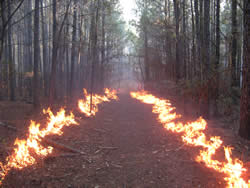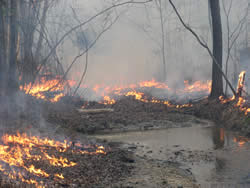
National Fire Plan Success Story
Success and Discovery
Congaree National Park, South Carolina
National Fire Plan - Fuels Reduction
2008

Upland ignition along an interior access road at Congaree National Park. NPS Photo by Cumberland Gap Fire Use Module.

Fire surrounds a floodplain slough at Congaree National Park. NPS Photo by Cumberland Gap Fire Use Module.
Prescribed fire is utilized at Congaree National Park to reduce hazardous fuels, restore natural processes, and promote native ecological communities. Fire has always been part of the natural ecosystem in South Carolina as it serves a critical role in restoring and maintaining long-leaf pine communities.
The Griffin's Creek Prescribed Fire at Congaree was accomplished in February 2008. Preparations were carried out utilizing volunteer student groups from Central Carolina Technical College, Alternative Youth Adventures, as well as National Park Service (NPS) staff. During site reconnaissance and planning, a section of small gauge rail, used regionally until the late 19th century, was found outside of the burn unit. During the Civil War, General Sherman's troops were known to destroy Confederate railroads by building fires with the railroad ties and melting the tracks. The discovery of this rail could serve as a potentially significant historical resource for the park, which will be further investigated.
NPS staff from the Cumberland Gap Fire Use Module, Great Smoky Mountains National Park, Big South Fork National River and Recreation Area, and Congaree National Park safely and efficiently implemented this fuels reduction project. Due to recent drought conditions, fire spread further into the floodplain than expected. Typically, wet soils serve as a barrier to fire; however a slow-backing fire crept into portions of the floodplain resulting in an additional 200 acres burned. More than 500 acres were burned during this project. The unique floodplain fire behavior coupled with the discovery of a potentially significant cultural artifact made this project a great learning opportunity and notable success for the NPS.
Contact: Eric Cope, Forestry Technician, phone: (276) 861-3418.